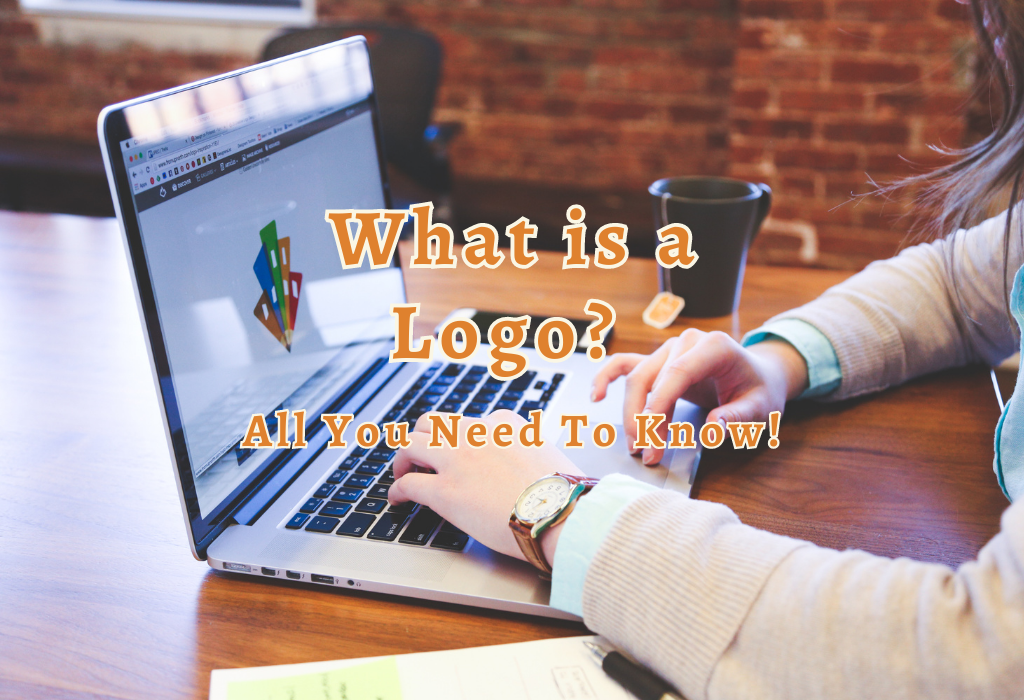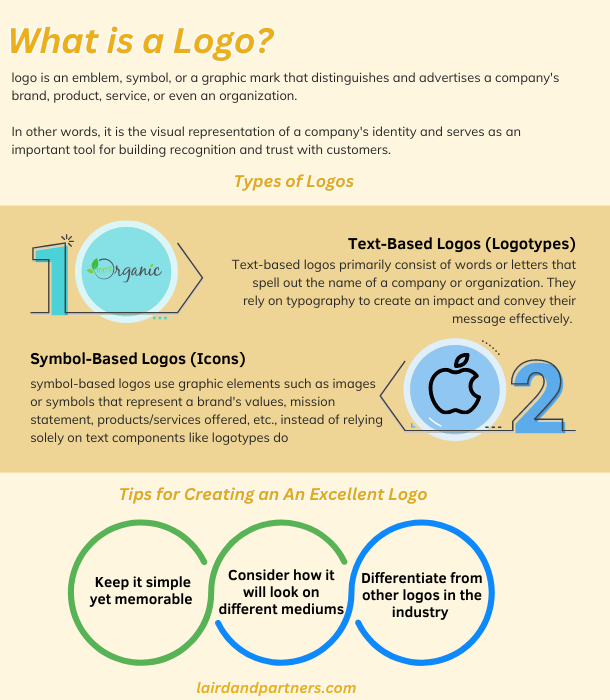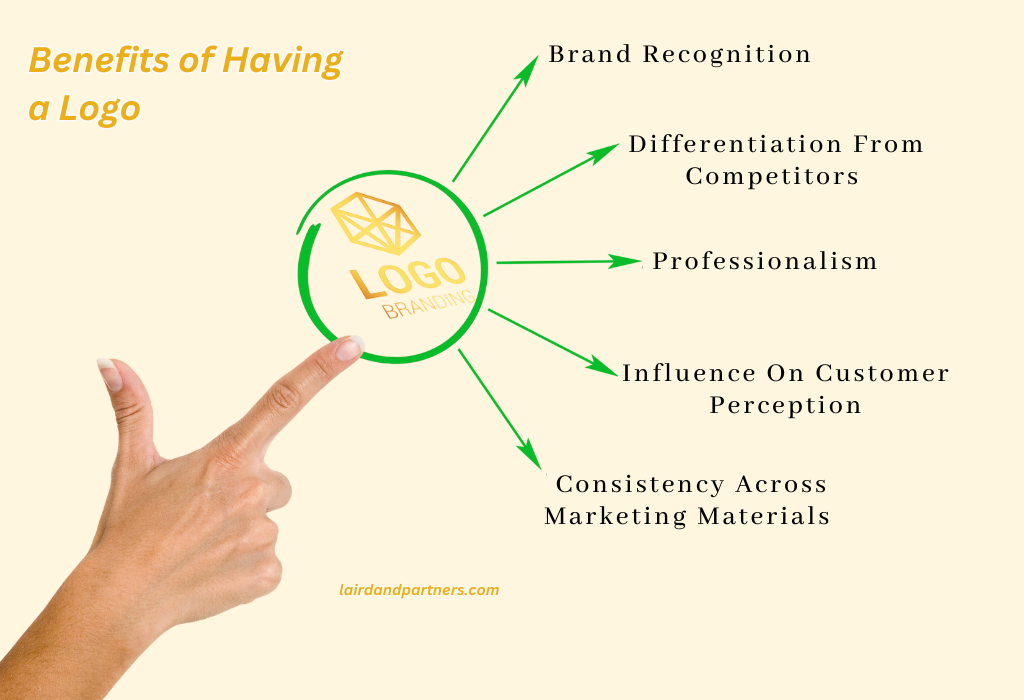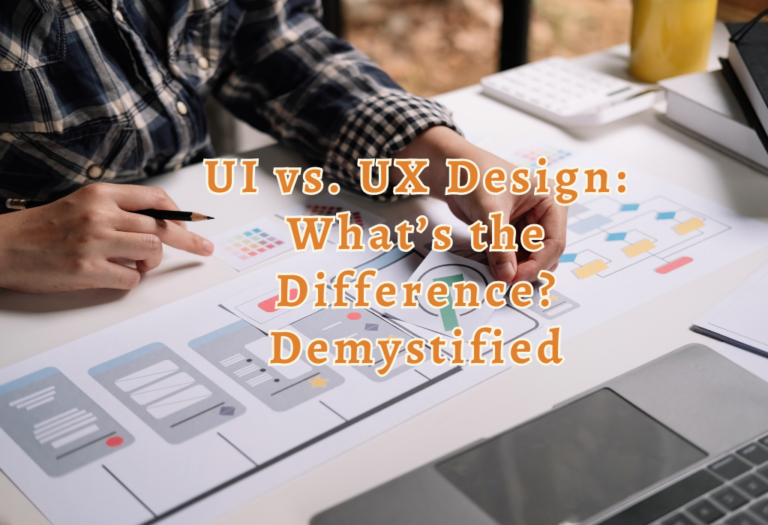What is a Logo? All You Need To Know!
What is a logo?
Put simply, a logo is an emblem, symbol, or a graphic mark that distinguishes and advertises a company’s brand, product, service, or even an organization.
In other words, it is the visual representation of a company’s identity and serves as an important tool for building recognition and trust with customers. A professionally-crafted logo can be instrumental in creating an immediate link between your business and its offerings, as well as setting it apart from other competitors.
Today, when businesses are constantly vying for attention online, having an eye-catching logo design acts as a spotlight for your business by creating a memorable impression on potential customers.
A logo is made through various graphic elements such as typography (fonts), colors, shapes (geometric or organic), symbols/icons/illustrations, etc.

More Resources :
Types of Logos

Logos are an essential piece of a brand’s visual identity, and the initial interaction between your business and its potential customers. There are two main categories of logos: text-based logos, also known as logotypes, and symbol-based logos, often referred to as icons. To decide which type of logo is best for your company, it’s important to understand the differences between text-based and symbol-based logos.
1. Text-Based Logos (Logotypes)
Text-based logos primarily consist of words or letters that spell out the name of a company or organization. They rely on typography to create an impact and convey their message effectively. Examples of well-known text-based logos include Google, Coca-Cola, and IBM.
2. Symbol-Based Logos (Icons)
In contrast, symbol-based logos use graphic elements such as images or symbols that represent a brand’s values, mission statement, products/services offered, etc., instead of relying solely on text components like logotypes do. Notable examples include Apple’s apple icon and Nike’s swoosh mark.
In some cases, businesses opt for a combination of both text and symbols in their logo design. This approach allows companies to benefit from the strengths of each type while mitigating any potential weaknesses. For example, McDonald’s golden arches are paired with its name written below it; this creates an iconic image while still ensuring clear brand identification.
Carefully select your logo as it creates an effective visual representation of your company’s identity. When deciding which category best aligns with your brand’s goals and values, consider factors such as simplicity vs. complexity, versatility across platforms and mediums, cultural relevance, etc.
Understanding The Process Of Logo Designing
The logo design process is a crucial aspect of creating an effective and memorable visual representation for your brand. It involves several stages, from research to final approval, ensuring that the end result accurately reflects your company’s identity and values while resonating with your target audience. In this part, we will look into each stage in depth.
- Research
Before diving into the design phase, you should first conduct a thorough research on your industry, competitors, and target audience. This helps you understand what works well within your niche and how you can differentiate yourself through a unique logo design.
- Brainstorming
Once you have gathered sufficient information about the market landscape, brainstorm various concepts that align with your brand’s personality and objectives. Consider different typography styles (fonts), color schemes (color meanings), and shapes (geometric or organic), symbols/icons/illustrations, during this stage.
- Sketching
After generating multiple ideas during brainstorming sessions, start sketching out rough drafts of potential logos by hand or using digital tools like Adobe Illustrator or Sketch App. This allows designers to quickly visualize their thoughts before moving onto more refined designs.
- Refining Concepts
As sketches evolve into more polished versions of potential logos, carefully consider which elements work best together in conveying the desired message effectively while maintaining simplicity yet memorability.
- Digital Mockups
Create high-quality digital mockups of selected concepts to evaluate how they will appear on various platforms, such as print materials and digital screens. This step helps identify any potential issues with scaling or legibility before finalizing the design.
- Testing Designs
Share your logo mockups with a sample of your target audience for feedback. This ensures that the design resonates well with them and meets their expectations while also identifying any areas for improvement.
- Making Revisions
Based on the feedback received from testing, make necessary revisions to refine and perfect your logo until it’s ready for approval by all stakeholders involved in the project.
Incorporating the necessary steps into your logo design will guarantee that you crafted a unique and memorable visual representation of your company which will not only be noticed, but also establish trust with customers. Remember, a good logo is essential in building a strong brand identity within today’s competitive marketplace.
The logo design process is a complex and creative journey that requires thoughtful consideration of the brand’s identity, mission, values, and goals. To ensure your logo stands out from the competition, it’s important to understand how different elements come together to create an effective visual representation for your business.
Let’s explore these essential components in more detail in our next section on Logo Design Elements.
Logo Design Elements
There are several key design elements that should be carefully considered when creating a logo, including typography, colors, shapes, symbols/icons/illustrations, textures/patterns/backgrounds, and negative space.
Typography (Fonts)
Different fonts can evoke different emotions or associations; for example, serif fonts tend to convey tradition and professionalism while sans-serif fonts often feel more modern and clean. When selecting a font for your logo design, consider how it aligns with your brand’s message and overall aesthetic.
Colors
When designing a logo, colors should be chosen carefully to create an emotional connection between the viewer and the brand while accurately reflecting your company’s values. Each color has specific psychological effects on human perception – red can signify passion or urgency while blue may evoke feelings of trustworthiness or stability. Be mindful of these associations when choosing colors for your logo so they accurately represent your company’s values.
Shapes (Geometric or Organic)
Selecting appropriate shapes based on their symbolism will enhance the visual impact of your logo design by making it more meaningful to viewers.
Symbols/Icons/Illustrations
Using symbols, icons, or illustrations in your logo can help communicate complex ideas more effectively and make it easier for people to remember. When choosing these graphic elements, ensure they are relevant to your brand’s message and resonate with the target audience.
Textures/Patterns/Backgrounds
Incorporating textures, patterns, or backgrounds into a logo design can add depth and interest while also reinforcing the overall aesthetic of the brand. However, be cautious not to overuse these elements as they may distract from the main focus – your company’s name or symbol.
Negative Space
Negative space is an often-overlooked aspect of logo design that refers to empty areas surrounding positive shapes within a composition. Clever use of negative space can create memorable visual effects by drawing attention towards specific parts of a logo or even forming secondary images that enhance its meaning.
Benefits of Having a Logo
By investing in a good logo, you can reap numerous benefits that contribute to the overall success of your company.

✅ Brand Recognition
When customers come across your logo in various places, such as websites, social media profiles or printed materials like business cards and brochures, they will quickly recognize it and associate it with the products or services you offer. This familiarity leads to increased trust and loyalty among customers.
✅ Differentiation From Competitors
A unique logo design sets you apart by conveying what makes you special compared to others offering similar products or services.
✅ Professionalism
An expertly designed logo demonstrates professionalism and commitment to quality – both important factors when potential clients are deciding whether to do business with you or not. A poorly designed or generic-looking logo may give off an impression that the company lacks attention-to-detail or doesn’t take its image seriously.
✅ Influence On Customer Perception
The graphic elements used in a logo design can subtly influence how people perceive your brand’s personality (e.g., modern vs traditional).
✅ Consistency Across Marketing Materials
Using the same logo on all of your marketing materials helps establish consistency in how customers perceive your brand. This cohesive visual identity makes it easier for people to recognize and remember you as they encounter various touchpoints along their customer journey.
Secret Tips for Creating an An Excellent Logo !
A well-designed logo is crucial for building brand recognition and setting your business apart from competitors. To create a memorable and impactful logo, consider the following tips:
- Keep it simple yet memorable
A good logo should be easy to recognize at a glance while still leaving a lasting impression on viewers. Avoid overcomplicating your design with too many graphic elements or intricate details.
- Consider how it will look on different mediums
Your logo should be versatile enough to work across various platforms such as print materials, digital screens, social media profiles, and even promotional merchandise like t-shirts or hats. Make sure it maintains its legibility when scaled up or down.
- Differentiate from other logos in the industry
To stand out among competitors, research existing logos within your niche market to avoid creating something too similar. Instead, aim for uniqueness without sacrificing clarity of message.
Invest in Professional Design Services
If you’re unsure about your design skills, consider hiring a professional designer or working with a web design company like Laird and Partners that specializes in creating visually appealing logos tailored specifically for brands seeking style, elevation, and cultural relevance.
Our skilled designers will provide valuable guidance on incorporating the right typography, colors, shapes, symbols, and illustrations into a cohesive and effective final product while adhering to best practices and industry standards.
Conclusion
In conclusion, creating an impactful logo requires careful consideration of various design elements combined with a strategic approach towards differentiation within the competitive marketplace. When executed successfully, this results in increased recognition and loyalty among customers as well as an improved overall perception of the business’s value proposition.

